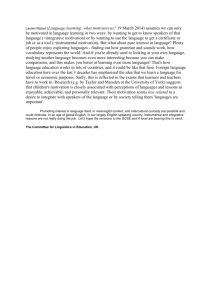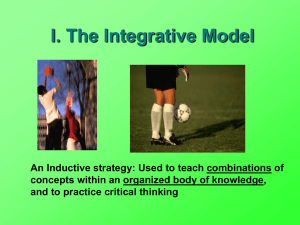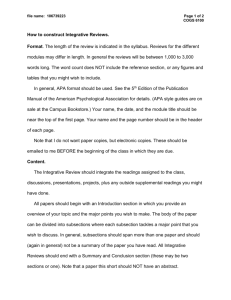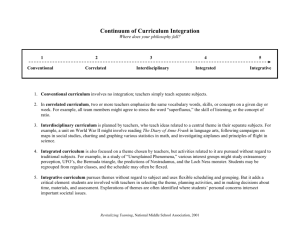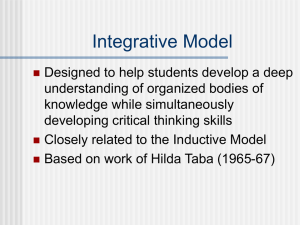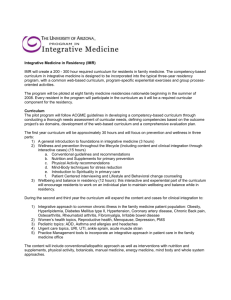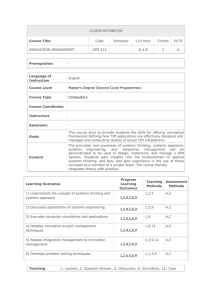USING Student created electronic magazines to promote integrative
advertisement
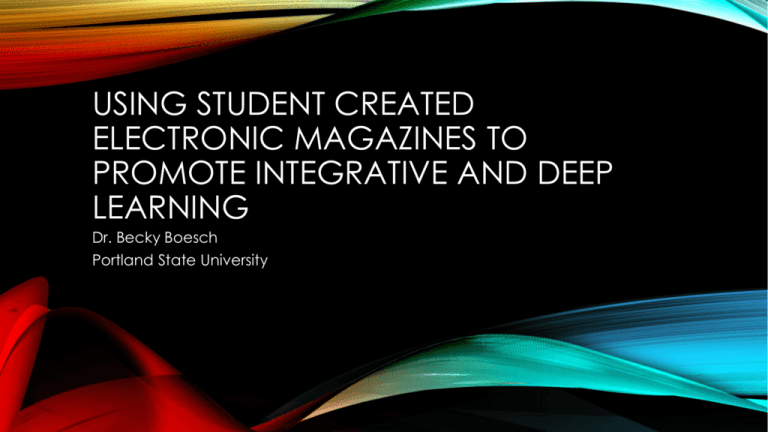
USING STUDENT CREATED ELECTRONIC MAGAZINES TO PROMOTE INTEGRATIVE AND DEEP LEARNING Dr. Becky Boesch Portland State University ADJUSTING TO A CHANGING WORLD • 21st Century Graduates Will change employers and even careers several times (Huber, Hutchings, & Gale, 2005). Will encounter a shrinking world culturally and socially. Will enter a world that requires them to make wise choices not just for themselves but for a larger world. • In response, Association of American Colleges and Universities (AAC&U) recommends four essential areas for all college students: Knowledge of human cultures and physical/natural world Intellectual and practical skills Personal and social responsibilities Integrative and applied learning INTEGRATIVE LEARNING • Integrative learning is helping students develop the ability to make connections and see relationships between subjects, themselves and the world around them. “Integrative learning is, at its core, a process of synthesizing learning across multiple experiences, coalescing meaning, and also creating new learning and meaning” ( Taylor, 2011). • Integrative learning differs from Interdisciplinary learning in that interdisciplinary learning draws connections between seemingly disparate areas of study. Integrative learning draws these connections but summarizes them into a larger understanding, a sum greater than the parts. DEEP LEARNING • Integrative learning only becomes permanent when deep learning occurs. Deep learning is meaningful, significant and life changing. For deep learning to occur it needs to include the following characteristics. 1. A well-structured knowledge base with a focus on concepts, integration of knowledge, and a cumulative experience. 2. An appropriate motivational level, with an emphasis on intrinsic motivation and a sense of “ownership” of the material (i.e. student driven learning). 3. Learner activity associated with active, not passive, learning. 4. Interaction with others, including student-teacher interactions and studentstudent interactions (McKay and Kember, 1997, p. 65). BACKGROUND TO THE PROJECT • Part of a year-long freshman general education course with four overarching goals: Inquiry and critical thinking Ethics and social responsibility Communication Diversity of Human Experience (These goals are in line with AAC&U guidelines) • Each term builds on the knowledge/skills from the previous term and revolves around the theme, Human/Nature, which explores the complex connections between humans and nature and draws upon such disciplines as Evolutionary Biology Neuroscience Linguistics Cultural Anthropology European and American History American Literature American Art Landscape Architecture Environmental History Conflict Resolution FINAL TERM ELECTRONIC MAGAZINE PROJECT • Research/explore current conflicts between humans and nature. These topics should involve different stakeholder groups in the conflict. The conflicts chosen should be two local, two regional/national and two international in scope. Some past topics chosen are: Wolves in Oregon Coal Trains in the Columbia River Gorge Invasive Aquatic Species in the Great Lakes Natural Gas Fracking Whaling in International Waters African Land Grab DESIGN OF THE COURSE AROUND THE PROJECT • Class chooses 6 topics. Groups of no more than 5 students choose to become the “experts” on a topic. These topics basically become the content of the class. • Specific activities associated which aid in the creation of the culminating project (electronic magazine) AND in the develop of integrative and deep learning Group researches and finds articles appropriate for the class to read on the topic. Group leads an entire class on the discussion of the topic and the articles assigned to be read. Each student in the group individually researches a specific stakeholder in the conflict and writes a research paper from that perspective Group finds raw numerical data on the conflict and translates that data into graphics and charts. Group collectively discusses and drafts a resolution to the conflict which takes into account all stakeholders’ concerns. Group presents this webpage and discusses both design and content with the class. COMPONENTS OF THE ELECTRONIC MAGAZINE • Create group contract with clearly delineated expectations • Collectively design overall format and organization of the website • Individually write a feature article on the conflict from a particular stakeholder perspective • Present numerical/statistical/graphical data critical to understanding the conflict • Share a joint solution which takes the major stakeholders into account • Include possible additional components such as reportage, opinion polls, book reviews, informational videos, relevant web sites….. • Evaluate fellow students on their group contribution and role ELECTRONIC MAGAZINE EXAMPLES • Local • http://coaltrains.weebly.com/ • Regional/National • http://teresauv.wix.com/thenuclearoption • http://mezaderic.wix.com/ocean-sounds • International • http://monopause.yolasite.com/ STUDENT FEEDBACK • Doing this project and listening to the presentations of the other e-magazines were great experiences because they made me more aware of what’s going on in the world, which is something I rarely experience in other classes. Being able to combine schoolwork and an important world issue is a very beneficial project and it makes engaging in my work much easier. • So…knowledge is not merely knowing things, like memorizing from a test, but truly understanding them and learning from them so you can use that information/understanding in other areas of your life. An education is not something you wait around for….there is always something to be learned, something beyond an “ought” or an “is” and this is how I see my education…something that is lifelong and is going to be layered and challenging but what will, in the end, make me a well-rounded person. BRAINSTORMING YOUR PROJECT • With 3 or 4 colleagues, think of a specific class/classes or programs where an electronic magazine project would be beneficial. Please pay attention to the following: What aspects of the project get specifically at integrative learning, i.e. “developing the ability to make, recognize, and evaluate connections among disparate concepts, fields, or contexts” (Huber, Hutchings, Gale, Miller & Breen, 2007, p. 46)? How can the project allow for deep permanent learning within the context of integrative learning? Deep learning should allow for student motivation and choice, active learning, and both student and faculty interaction. (15-20 minutes) GROUP IDEAS REFERENCES Huber, M.T., Hutchings, P., Gale, R., Miller, R. & Breen, M. (2007, Spring) Leading initiatives for Integrative learning. Liberal Education, 93(2), 46-51. McKay, J., & Kember, D., (1997). Spoon feeding leads to regurgitation: A better diet can result in digestible learning outcomes. Higher Education Research and Development (6)1, 55-67. Rhodes, T.L. (Ed.) (2010). Assessing outcomes and improving assessment: Tips and tools for using rubrics. Washington D.C.: Association of American Colleges and Universities. Taylor, S.H. (2011, November-December). Engendering habits of mind and heart through integrative learning. About Campus, 13-20.

